

SURVEY is the foundation of a building conservator’s work and includes the survey of the built environment as well as the survey of existing documents. Site survey work involves the observation and documentation of existing buildings and historic sites, often using access equipment to get up close. Field notes, sketches, photographs, and measurements will be taken to record the findings of the survey. To further investigate certain types of problems, survey work may also include taking material samples for testing, removing finish materials to reveal hidden areas of deterioration, monitoring conditions, and cleaning tests.
Survey work should also include a review of existing documents to understand how the site has changed over time. Documents that can provide helpful information include previous reports and the owner’s records, as well as historical documents, photographs, and maps. The survey of the site and existing documents is complementary and each informs the other.

ASSESSMENT is the analysis of the information gathered during survey. The information is synthesized in order to summarize the research, to identify patterns that may indicate system-wide problems, and to prioritize the severity of conditions. Assessment may involve additional research and material testing to determine the best solutions for the problems observed.

DOCUMENTATION is the actual product to expect from a building conservator, which should explain the extent and findings of the survey and assessment through graphics and written reports. The type of documentation you receive can vary greatly depending on your needs and budget. A preliminary study may only contain a letter report illustrated with photographs and field notes. An in-depth historic structures report or similar study would have multiple chapters, appendices, measured drawings and drawings showing alternatives for proposed changes. As part of a design team, a building conservator can also produce construction documents, including drawings and specifications, which conform to the requirements of the set.

One of the most valuable services provided by a building conservator is their recommendations for making appropriate repairs and undertaking proper maintenance for existing buildings and sites. An “appropriate” repair is one that is well-matched to the type and condition of the material or assembly to be repaired; one that is designed for long term durability; one that is well-suited to how the repair will be installed and by whom; and one that works within the anticipated maintenance for the existing building or site. A building conservator, as part of the design team, can help ensure that changes made to the existing fabric provide the best performance over the long term.












